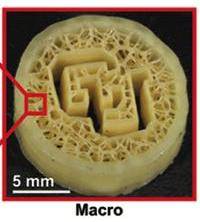A new liquid crystal material 3D-printed into complex structures can mimic cartilage and other biological tissue, leading the way towards printed spinal discs and other biomedical implants
Mechanical engineer Professor Chris Yakacki at the University of Colorado Denver led the team that developed and applied the new material.“Everyone’s heard of liquid crystals because you stare at them in your phone display,” said Yakacki. “And you’ve likely heard of liquid crystal polymers because that’s exactly what Kevlar is. Our challenge was to get them into soft polymers, like elastomers, to use them as shock absorbers. That’s when you go down the layers of complexity. The researchers used a 3D printing process called digital light processing (DLP). They developed a ‘honey-like’ liquid crystal resin that cures when hit by ultraviolet light, forming new bonds in a succession of thin photopolymer layers. The final cured resin reportedly forms a ‘soft, strong, and compliant’ elastomer. When printed in lattice structures resembling honeycomb, the material begins to mimic strong and elastic cartilage.
The researchers used a 3D printing process called digital light processing (DLP). They developed a ‘honey-like’ liquid crystal resin that cures when hit by ultraviolet light, forming new bonds in a succession of thin photopolymer layers. The final cured resin reportedly forms a ‘soft, strong, and compliant’ elastomer. When printed in lattice structures resembling honeycomb, the material begins to mimic strong and elastic cartilage.
The group printed several structures including a tiny lotus flower model and a prototype of a spinal fusion cage, which included fine detail in a large structure. The combination of resin and printing process reportedly achieved up to 27-times greater strain energy dissipation compared to commercially available photocurable elastomer resins. The team suggested the printed structures could be used in small biomedical implants in toes, or even in the spine.
“The spine is full of challenges and it’s a hard problem to solve,” said Yakacki. “With 3D printing, and the high resolution we’ve gotten from it, you can match a person’s anatomy exactly. One day, we may be able to grow cells to fix the spine, but for now, we can take a step forward with the next generation of materials. That’s where we’d like to go.”
Other potential applications include shock-absorbing foam for American football helmets.
The research was published in Advanced Materials.
This work was supported by the US Army Research Laboratory and US Army Research Office, an NSF CAREER Award, and the Laboratory Directed Research and Development programme at Sandia National Laboratories, for the US Department of Energy’s National Nuclear Security Administration.
Source: Institution of Mechanical Engineers. https://www.imeche.org



